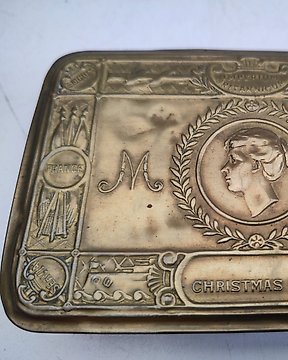
Britisk gaveeske julen 1914 - Militært tilbehør
Nr. 81370649

Nr. 81370649

Nice 100% original WW2 Class A Wool Tunic, a nice large size, and complete, of a soldier within the 10th US Airforce attached to the the CBI (China Birma India Theatre group) during WW2. The tunic has originally a beautiful BULLION(!!) luxury purchase CBI patch and a nice 10th US Airforce patch. The jacket came with a set of 3 overseas bars, showing he served at least 1,5 years in the harsh conditions of the CBI and the Pacific. The overseas bar patch was glued to the jacket long time ago, you can clearly see it has been there for a long time, but came loose. This could be easily fixed or restitched so you dont see the stains anyway. It has been used in the war, so wear is present on this uniform, but nothng major.
A very nice and 100% original wool a-class jacket of the famous CBI group!
History of the 10th US Army Airforce and the CBI
Under General Clayton Bissell's re-organization of the Tenth Air Force, five commanders reported to him: Brigadier General Caleb V. Haynes ran the India Air Task Force, created 8 October 1942, Brig. Gen. Claire Chennault ran the China Air Task Force, created 4 July 1942 to replace the American Volunteer Group, Robert F. Tate ran the India–China Ferry Command, Robert C. Oliver ran the Tenth's service arm and Francis M. Brady operated the large air base at Karachi.[3] Haynes's task force assembled three bomber groups: the 7th Bombardment Group, the 51st Fighter Group and the 341st Bombardment Group (Medium). On paper were more squadrons not yet prepared for war—some had no aircraft, some had too little training and some were bare cadres.[3]
In March 1943 the China Air Task Force was dissolved and its components made part of the new Fourteenth Air Force, activated in China under Chennault. The Tenth operated in India and Burma as part of the Allied Eastern Air Command until it moved to China late in July 1945.[4]
The Tenth Air Force conducted offensive strategic bombing operations in Burma and Thailand and supported Allied ground efforts with close air support and operations against Japanese communications and supply installations. After the end of the war in China, the command headquarters departed from Shanghai on 15 December 1945, being attached to Army Service Forces at Fort Lawton, Washington, where the last personnel were demobilized and the command inactivated, being returned to HQ USAAF on 6 January 1946.
China Burma India Theater (CBI) was the United States military designation during World War II for the China and Southeast Asian or India–Burma (IBT) theaters. Operational command of Allied forces (including U.S. forces) in the CBI was officially the responsibility of the Supreme Commanders for South East Asia or China. However, US forces in practice were usually overseen by General Joseph Stilwell, the Deputy Allied Commander in China; the term "CBI" was significant in logistical, material and personnel matters; it was and is commonly used within the US for these theaters.
U.S. and Chinese fighting forces in the CBI included the Chinese Expeditionary Force, the Flying Tigers,[1] transport and bomber units flying the Hump, including the Tenth Air Force, the 1st Air Commando Group, the engineers who built the Ledo Road, the 5307th Composite Unit (Provisional), popularly known as "Merrill's Marauders", and the 5332d Brigade, Provisional or 'Mars Task Force', which assumed the Marauders' mission.
Hvordan kjøpe på Catawiki
1. Oppdag noe spesielt
2. Legg inn det høyeste budet
3. Å gjøre en sikker betaling